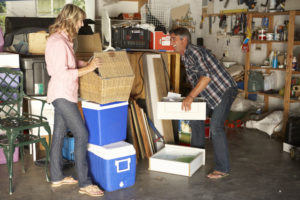How Can Your Leadership Benefit From Tidying Up?

 I’m great at organizing ideas, people, and concepts. Please don’t give me a closet to organize. Or a garage.
I’m great at organizing ideas, people, and concepts. Please don’t give me a closet to organize. Or a garage.
My closets and my garage are without heart. Remorseless in their demands for order. They will take on a life of their own if I don’t attempt to intervene periodically.
After three summers in a row of avoiding my garage, I realized I needed to man up and face the monster. To do so, I began by delaying. I used my favorite tactic, which is: “I need to study this first.”
In this instance, the oracle of Amazon recommended that I read, “The Life-Changing Magic of Tidying Up” by Marie Kondo. This article will not be a review of that book. It likely won’t even be a decent representation of Kondo’s concepts. But that book (and the subsequent tidying it provoked) has led to some important insights on leadership.
Keep Reading: This Relates To Your Effectiveness As A Leader!
I purchased the book. One of Kondo’s central concepts in tidying is a mindset. She instructs you to begin by taking everything you own and dumping it in a big pile on the floor. Then go through it all. Touch each thing. If it doesn’t bring you “joy”, get rid of it. Then put the rest away.
She’s opposed to starting out with organizational or storage methods. She’s big on getting rid of stuff. She also talks about the emotional experience that comes with this. That part was weird. I didn’t give it a lot of thought.
Kondo recommends beginning with clothes. Apparently, they are easier. So, that’s where I started. I didn’t think that I had a lot of clothes. Everything I own is in one modestly sized closet. I don’t shop often. No seasonal wardrobes that get swapped out. What’s there is there.
I went through the process. I ended up with five garbage bags of clothes that I didn’t wear, like, want or didn’t bring me “joy” when I held them. I also ended up with one bag of pure garbage. Clothes that were torn or stained and, at best, fit for rags.
Six stuffed garbage bags of clothes discarded. With plenty left over. Before I did this, I would have told you that my closet couldn’t even hold six garbage bags of clothes. Apparently, there was a lot of unknown room for the unwanted and unnecessary.
I did the same thing in my garage. I ended up discarding well over half of what I had. That surprised me. If someone had told me that half of what I owned in my garage was worthless to me, I would have told them they were wrong. If anything, I needed more tools and stuff in my garage. You know. Tools. Need them.
Here is what really surprised me. The emotional experience. It was real. I can feel it now. It was like a liberation. I feel lighter. Freer. I feel differently when I look back into my closet or into my garage. A burden I didn’t know was there, is gone.
Here’s What I Learned
Junk: I was holding onto a lot of junk. Torn, worn out, stained clothes. Car parts to cars I didn’t own anymore. Mostly empty bottles of mystery chemicals that looked like they’d probably burn the house down. Jars full of what looked like post-construction site floor sweepings. Empty boxes.
Unpleasant Memories: Much of what I was storing were items of significance to me. I acquired them during situations of significance. I knew that, so I kept them.
But when I reflected on if they gave me a sense of “joy” I realized that most didn’t. This was a surprise. For many, I actually felt disappointment, or loss or some other negative feeling. While there is nothing wrong with those feelings, I was confronted with the question: “Why am I hanging onto them?” They brought me no present value.
Unhelpful Mindsets: I would say that many of the items I discarded probably fit into two general categories:
- Vicarious & Unrealized Hopes: For example, I realized I had decades old t-shirts that reminded me of relationships that I valued but, upon reflection, didn’t feel valued by. Experiences that were aspirational to me then but not a part of my identity now.
I was holding onto unrealized hopes and relationships from the past. None of which had value in my life now.
- Scarcity: I was raised with a scarcity mentality. My family, my community, and most people I was around believed that there was only so much to go around in life. That it was very difficult to attain things but very easy to lose them. Frugality was the highest economic virtue.
- I was holding onto clothes that didn’t fit and I didn’t like but “might” wear. I was holding onto car parts for cars I didn’t own anymore. Tools to fix things that I have no business trying to fix.
I was stockpiled, afraid to let go, afraid that I wouldn’t have what I need when I needed it. I was holding onto the mindset of scarcity.
I felt real freedom from putting those mindsets to rest. Discarding was a very real way of saying, “That’s who I was. Those things, and the memories attached to them no longer serve me now. They don’t reflect who I am or who I desire to become.
Tidying drew an unexpected line in the sand. I stepped over it. It was much better on the other side.
I can also find things in my garage now. That’s also nice.
OK, The Leadership Lesson:
I have the opportunity to work with a lot of leaders. Many of whom have experienced meaningful success. I’ve observed that most leaders, even the successful ones, hold onto too much. They clutch leadership versions of Junk, Unpleasant Memories and Unhelpful Mindsets.
They often hire me to try to organize this stuff. To make sense of it. To make it work now. They often resist when I suggest that perhaps we should start letting go.
It’s hard to let go.
There are three areas where I see this show up in leaders.
Leadership Junk: Leadership junk might be leadership methods that worked in one situation but don’t work in our current one. It might be physical stuff, insisting on coaxing the last gasps out of an antiquated computer system. It might be (and junk is a harsh word) avoiding the need to address performance or behavior issues in a co-worker or employee.
Unpleasant Memories: Many organizational policies and leadership decisions are not based on what is happening now. They are based on something that happened a long time ago. (I was once asked to work with a board that was still fighting the newest manifestation of a 55-year-old conflict.) Leaders are, too often, reacting to something that happened decades ago. As opposed to what is right in front of them.
It is common to review the handbook, by-laws, and policies of a company and hear an echo of unpleasant memories. When this happens, the vision, values or aspirations of the organization are subducted by institutionalized fear, disappointment or anger.
Unhelpful Mindsets: Here are examples of a few unhelpful mindsets that leaders commonly hold onto:
- Scarcity vs Creation: Believing that things are likely to run out, get worse or fall apart as opposed to being able to create new value, revitalize circumstances or improve situations.
Impact: Prevents creativity and innovation. Tends towards fatalism. Will defer their ability to act to improve or change their situation.
- Victim-stance vs Ownership: Believing that life “happens” to me and often in a negative way. I don’t “happen” to life. Other’s choices are intentional and fully their fault. Mine are understandable, have context and not fully within my control.
Impact: Tends towards blame and conflict. Tends to avoid or rationalize ownership for mistakes or offenses. Needs to stay in control.
- Zero-Sum/Black or white thinking: Believing that life is full of only binary options. Either I get all of what I want and how I wanted it or I won’t get anything. Either you accept all of my ideas and behavior or you have rejected all of me. The converse of this is, if you aren’t perfect you are all wrong and unacceptable.
Impact: Perfectionism. Intolerance or lack of patience for other’s growth curve. Defensiveness and/or avoidance of issues or criticism.
There are other limiting mindsets as well. While we may have very understandable back-stories to our current mindsets, they no longer serve us well.
It is time to open the garage door of our leadership lives, pull everything out, and start discarding.
Take good care,
Christian
How Can Your Leadership Benefit From Tidying Up?
Are you facing repeated issues or challenges in your organization? Do you find that you keep bumping up against the same limits? Do you find yourself responding in ways that are unhelpful but are difficult to change?
Would you like help “tidying up” your leadership? If so, I have something for you. I have a few slots on my calendar to speak with you one-on-one about the best practices for quickly improving your leadership impact.
Due to my schedule, I only have a few slots open for this complimentary call on a first-come-first-served basis.
Email me at Christian@vantageconsulting.org or call me at 907 522-7200.
Article Categories
Popular articles

Download my free 10-page eBook:
How To Accomplish More Without Doing More:
Eight Proven Strategies To Change Your Life
Discover how to save eight hours during your workweek-even if you're too busy to even think about it. The resource every maxed out executive needs.